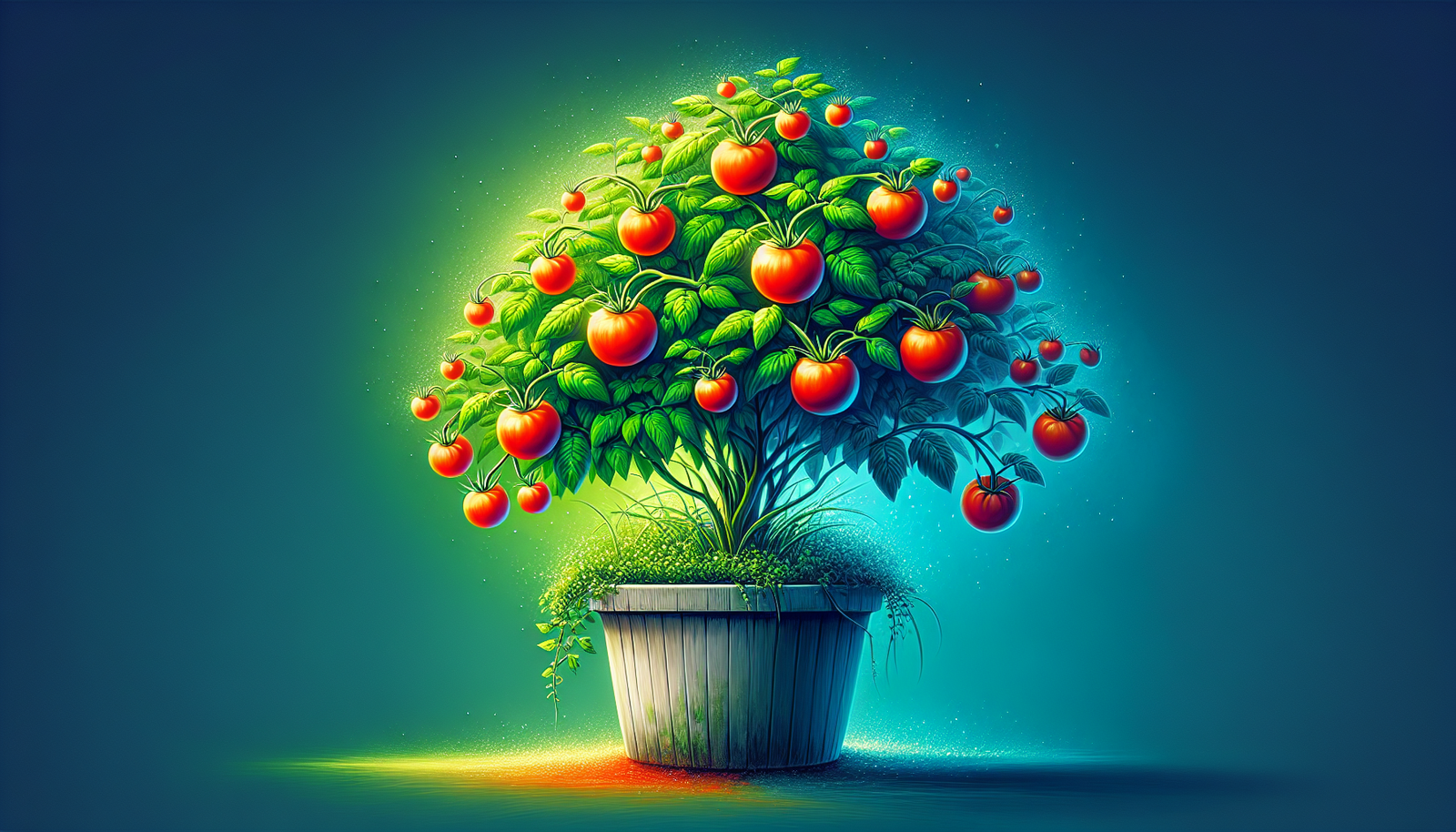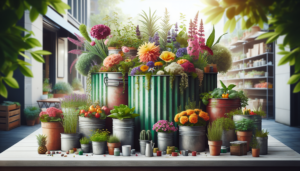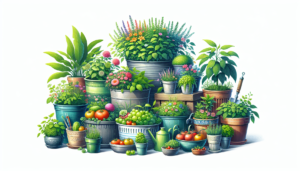
Container gardening is a popular and accessible way to bring nature and greenery into any space, whether you have a large backyard or a tiny balcony. This article will explore the benefits and drawbacks of container gardening, providing you with valuable insights to help you decide if this gardening method is right for you. From the flexibility of design and the ability to grow plants in any location, to the challenges of limited root space and potential for overwatering, we’ll cover it all. So sit back, relax, and let’s explore the pros and cons of container gardening together.
Advantages of Container Gardening
Flexibility in Location
One major advantage of container gardening is the flexibility it offers in terms of location. Unlike traditional gardening methods that require a fixed outdoor space, container gardening allows you to adapt your garden to fit any available area. Whether you live in an apartment with a small balcony or have a limited yard space, you can still indulge in the joy of gardening. Containers can be placed on patios, rooftops, windowsills, or even hanging from walls, giving you the opportunity to create a beautiful green oasis wherever you desire.
Maximizes Small Spaces
If you have limited space, container gardening is a fantastic solution. Containers come in various sizes, allowing you to maximize every inch of your available space. You can stack containers vertically or arrange them in tight rows, optimizing the use of your balcony, porch, or small yard. By utilizing vertical spaces, you can grow a wide range of plants, vegetables, and herbs, expanding your gardening possibilities without sacrificing precious square footage.
Easy Access and Mobility
Container gardening provides easy access to your plants, making tending to them a breeze. No longer will you have to kneel in the dirt or bend over for hours, straining your back. With containers, you can maintain an elevated garden, ensuring a comfortable gardening experience. Furthermore, containers offer mobility, allowing you to move your plants as needed. This is particularly beneficial if you live in regions with harsh weather conditions. On hot summer days, you can relocate your plants to a shadier spot, and during frosty nights, you can bring them indoors. Such flexibility ensures the optimal growth and health of your plants throughout the seasons.
Better Pest Control
Container gardening can provide better pest control compared to traditional gardens. With plants elevated in containers, they are less susceptible to ground-dwelling pests and diseases. Slugs, snails, and certain insects that often ravage gardens will find it more difficult to reach your plants. Additionally, containers can be placed closer to your home, allowing for regular monitoring and early detection of any potential pest issues. By addressing these problems promptly, you can mitigate damage and ensure the overall health of your plants.
Less Weeding and Maintenance
One significant advantage of container gardening is the reduction in the amount of weeding required. Unlike traditional gardens where weeds can quickly overtake the space, containers confine the growing area, limiting the chances of weed growth. You won’t have to spend hours on your knees, pulling out unwanted plants. Additionally, container gardens generally require less overall maintenance. There is no need for tilling or cultivating large areas, and you can easily control the amount of water, fertilizer, and sunlight each plant receives. This efficiency saves both time and effort while still allowing you to reap the rewards of a thriving garden.
Customizable Soil and Drainage
Container gardening enables you to have complete control over the soil composition and drainage system for your plants. Unlike traditional gardens where the existing soil quality may be less than ideal, you can tailor the potting mix to suit the specific needs of each plant. This can include adjusting the pH level, adding organic matter, or incorporating nutrients. Additionally, containers allow for proper drainage, preventing waterlogged roots which can cause harm to plants. By customizing the soil and providing adequate drainage, you can optimize the growing conditions for each plant, ensuring their health and vitality.
Reduced Risk of Soil-Borne Diseases
Another advantage of container gardening is the reduced risk of soil-borne diseases. Traditional gardens can harbor various fungal, bacterial, and viral pathogens that may affect the health of your plants. However, with container gardening, you have the opportunity to start with fresh potting mix, minimizing the chance of introducing diseases to your garden. This is particularly beneficial if you have had previous struggles with soil-borne diseases in your traditional garden. By practicing container gardening, you can protect your plants from these potentially devastating infections, ensuring their longevity and productivity.
Creates Visual Appeal
Container gardening allows you to embrace your creativity and create stunning visual displays. With a wide variety of containers available, including different shapes, sizes, and materials, you can add a unique touch to your garden. From colorful ceramic pots to elegant hanging baskets, each container can complement your personal style and enhance the aesthetic appeal of your outdoor or indoor space. You can experiment with different plant combinations, varying heights, and textures to create eye-catching arrangements that are sure to impress both visitors and yourself.
Promotes Plant Diversity
Container gardening provides ample opportunities to promote plant diversity. Unlike traditional gardens where you may be restricted by the nature of your soil and climate, containers offer flexibility in what you can grow. You can cultivate a wide assortment of plants, including various flowers, herbs, vegetables, and even dwarf fruit trees. This diversity not only adds visual interest but also encourages ecological balance by attracting beneficial pollinators and deterring harmful pests. By incorporating different plant species, you can create a vibrant ecosystem within your container garden, contributing to the overall health and sustainability of your plants.
Enables Season Extension
Container gardening allows you to extend the growing season, enabling you to enjoy fresh produce and flowers for a longer period. Containers can easily be moved indoors or to protected areas during colder months, allowing you to continue growing plants that would otherwise be at risk of frost damage. By using cold frames, cloches, or even just positioning containers against the sunny side of a wall, you can create microclimates that mimic a warmer environment. This means you can savor homegrown goodness even when the weather outside is less than ideal. Container gardening opens up possibilities for year-round gardening, no matter where you live.
Disadvantages of Container Gardening
Limited Root Space
One disadvantage of container gardening is the limited root space available for your plants. While containers come in various sizes, they are still confined in comparison to a traditional garden bed. This can limit the growth and development of certain plants, particularly those with deep root systems. It’s important to choose plants that are suitable for container gardening and have compact or shallow root structures to ensure they can thrive in the confined space provided by the container.
Dependency on Watering and Fertilizing
Container gardening requires a higher level of attention to watering and fertilizing compared to traditional gardens. Containers tend to dry out more quickly, especially during hot weather, requiring regular watering to prevent dehydration of the plants. Fertilizing is also crucial as the nutrients in the potting mix may deplete faster compared to the nutrients available in the ground. You need to monitor the nutrient levels and adjust the fertilization schedule accordingly to ensure your plants receive the necessary nourishment.
Susceptibility to Heat and Cold Stress
Plants in containers are more susceptible to heat and cold stress than those in the ground. The confined space of a container can cause the roots to heat up or freeze more rapidly, potentially damaging or killing the plant. During scorching summer days or frigid winter nights, additional measures may be required to protect your container garden. You may need to provide shade or insulation to shield your plants from extreme temperatures and maintain a stable growing environment.
Requirement for Frequent Monitoring
Container gardening demands regular monitoring to ensure the optimal growth and health of your plants. You must frequently assess the moisture levels, taking care not to overwater or let the containers dry out completely. Regular inspections for pests, diseases, and nutrient deficiencies are also important to catch any issues early on. Unlike traditional gardens that can be more self-sustaining, container gardens require your proactive attention to maintain the well-being of your plants.
Risk of Overwatering or Poor Drainage
Container gardens can be at risk of overwatering or poor drainage, which can lead to root rot and other root-related diseases. Because containers have a limited volume of soil that can hold water, it’s essential to find a balance between providing adequate moisture and preventing waterlogged conditions. Choosing containers with drainage holes and using well-draining potting mix can help improve drainage. Regularly checking the moisture level and adjusting your watering practices accordingly is crucial to prevent these issues.
Reliance on Container Quality
The success of your container gardening greatly depends on the quality of the containers you choose. Inferior quality containers may break, crack, or have poor drainage, which can negatively impact the health of your plants. It’s important to invest in durable, well-constructed containers that are made from materials suitable for your specific plants and climate. By selecting containers with the right features, you can ensure the longevity and performance of your garden.
Restricted Plant Size and Variety
Container gardening may limit the size and variety of plants you can grow. Some plants, such as large trees or sprawling vegetables, may not thrive or require substantial maintenance in containers. Furthermore, the size of the container may restrict the amount of soil available, impacting the overall growth potential of certain plants. It’s essential to choose plants that are well-suited for container gardening, considering their mature size and growth habits.
Higher Initial Costs
Starting a container garden can involve higher initial costs compared to traditional gardening. Along with the plants themselves, you need to invest in good-quality containers, potting mix, fertilizers, and other necessary gardening supplies. Depending on your desired level of aesthetics and functionality, these costs can add up. However, it’s important to keep in mind that container gardening offers long-term benefits and that the initial investment can be offset by the joy and rewards of a flourishing garden.
Increased Vulnerability to Wind
Container gardens are more susceptible to wind damage compared to plants in the ground. The elevated position and lightweight nature of containers make them prone to toppling over or being blown away by strong winds. It’s crucial to select stable containers and position them in sheltered areas or secure them with stakes or weights to minimize the risk. Additionally, choosing wind-resistant plants and arranging containers in clusters can provide added protection to your container garden.
Lack of Soil-Beneficial Organisms
Container gardening lacks the natural balance of soil-beneficial organisms that exist in traditional gardens. These organisms support soil health, nutrient cycling, and pest control. In containers, the sterile potting mix does not have the same diversity of microorganisms, earthworms, and other beneficial creatures. This imbalance may necessitate the need for additional soil amendments and fertilizers to maintain soil fertility and ensure optimal plant growth.
In conclusion, container gardening offers numerous advantages, including flexibility in location, maximizing small spaces, easy access and mobility, better pest control, less weeding and maintenance, customizable soil and drainage, reduced risk of soil-borne diseases, creating visual appeal, promoting plant diversity, and enabling season extension. However, it also comes with some disadvantages, such as limited root space, dependency on watering and fertilizing, susceptibility to heat and cold stress, requirement for frequent monitoring, risk of overwatering or poor drainage, reliance on container quality, restricted plant size and variety, higher initial costs, increased vulnerability to wind, and lack of soil beneficial organisms. Despite these drawbacks, with proper care and attention, container gardening can be a rewarding and enjoyable way to cultivate a thriving garden in any space, whether large or small.







